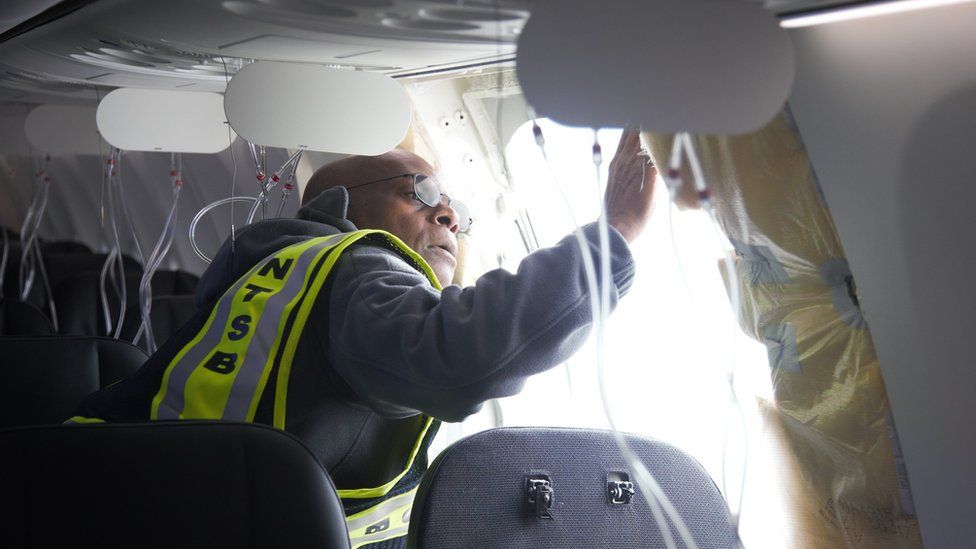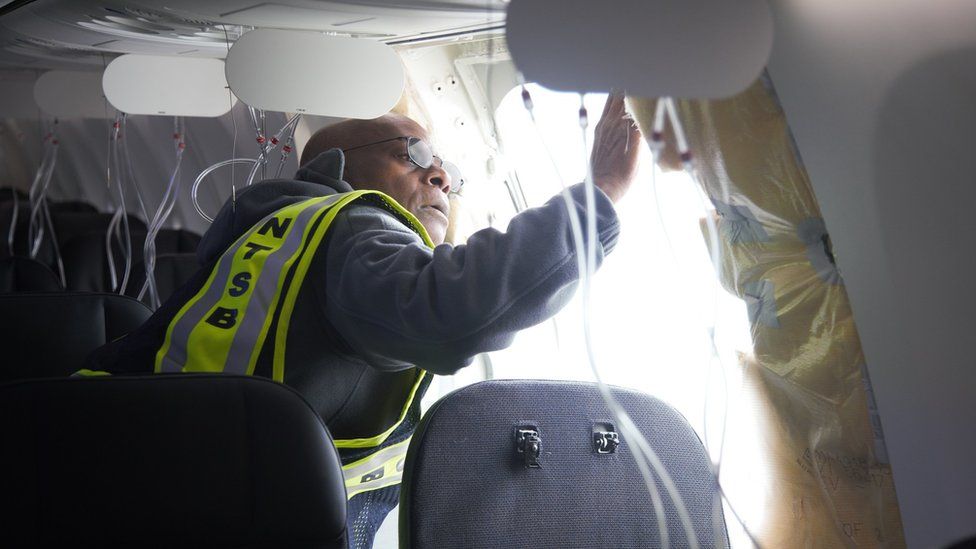
A door that blew away from a Boeing 737 Max shortly after take-off may not have been properly secured, a new report says.
The US National Transportation Safety Board has released initial findings from its probe into the incident on an Alaska Airlines plane in January.
It says four key bolts that were meant to lock the unused door to the fuselage appeared to be missing.
Replying to the report, Boeing said it was accountable for what happened.
In a statement, Boeing’s president Dave Calhoun said: “An event like this must not happen on an airplane that leaves our factory. We simply must do better for our customers and their passengers.”
“We are implementing a comprehensive plan to strengthen quality and the confidence of our stakeholders,” he added.
The incident happened minutes after Alaska Airlines Flight 1282 took off, and involved a panel covering an unused emergency exit – known as a door plug. This suddenly blew out, leaving a gaping hole in the side of the main body of the aircraft, the fuselage.
The missing bolts appeared to have allowed the door panel to move out of position and break away from the aircraft, the report says.
It happened just moments after the flight took off from Portland International Airport.
The plane then suffered a rapid loss of cabin pressure, as air rushed out and the atmosphere within the plane equalised with the thinner air outside.

The door plug was manufactured by Boeing’s supplier Spirit AeroSystems, and originally installed in the fuselage before being delivered to the aerospace giant.
According to the preliminary report, this door plug was later removed in the factory due to damage that had occurred during the production process.
Photographic evidence suggests that when the plug was reinstalled, at least three of the four locking bolts were not put back in place.
Damage to the door plug and its hinges, as well as a lack of damage to the areas where the bolts should have been, suggests that the bolts were missing before the door moved out of its normal position, the report said.
Spirit AeroSystems said it remain focused on working closely with Boeing and regulators “on continuous improvement in our processes and meeting the highest standards of safety, quality and reliability”.
The findings are likely to make uncomfortable reading for Boeing, which has already faced harsh criticism over its corporate culture and quality control processes.
Inspections have already revealed loose bolts and fixings on other planes of the same specification, raising questions about the way they were built.
In his response, Boeing’s president and chief executive said its improvement plan would “take significant, demonstrated action and transparency at every turn”.
Mr Calhoun said the airline manufacturer would implement new inspections of door plug assembly and fully document when the plug is removed.
Additional inspections into the supply chain and an independent assessment would also be included in the plans.
“This added scrutiny – from ourselves, from our regulator and from our customers – will make us better. It’s that simple,” Mr Calhoun said.
A history of problems
Prior to the Alaska Airlines incident, there had been other serious problems on the 737 Max production line, including the discovery of manufacturing defects affecting key parts of the planes, as well as a part protecting the central fuel tank against lightning strikes.
The scrutiny is all the more intense because of the history of the 737 Max itself.
The plane – a new version of Boeing’s decades old workhorse – was involved in two major accidents in late 2018 and early 2019, in which 346 people were killed.
- Boeing 737 Max: What went wrong?
- Passenger plane crashes in sea off Jakarta
Those crashes were attributed to badly-designed flight control software, which forced both aircraft into catastrophic dives that the pilots were powerless to prevent.
In the aftermath, Boeing faced accusations from lawmakers and safety campaigners that it had put profits above the safety of passengers.
Testifying before US lawmakers today, the head of the Federal Aviation Administration (FAA), Mike Whitaker said inspections of 737 Max aircraft had shown that “the quality system issues at Boeing were unacceptable and require further scrutiny”.
He promised to put more “boots on the ground” in Boeing’s factories in order to increase scrutiny of the manufacturer.
Boeing would be held accountable for any future failure or refusal to comply with the FAA, he added.
Last month, Boeing’s chief executive Dave Calhoun told staff at the company it would co-operate with investigators and regulators “to ensure all the procedures are put into place, inspections, all the readiness actions that are required to ensure every next airplane that moves into the sky is in fact safe and that this event can never happen again”.
Related Topics
- Companies
- Aviation accidents and incidents
- Boeing
-
Boeing safety checks to use ‘more boots on ground’
-
8 hours ago

-
-
Key questions behind plane’s mid-air blowout
-
9 January

-





